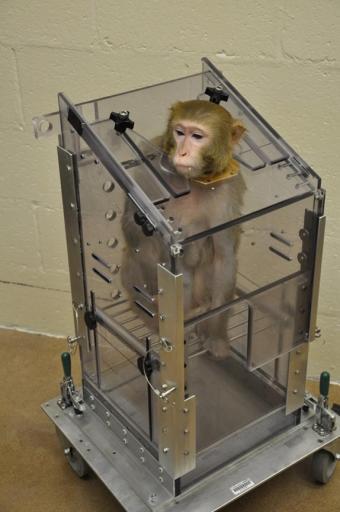Physicians Committee’s Response to “Neuralink’s Commitment to Animal Welfare”
On Feb. 14, 2022, Neuralink posted a statement to its website filled with factually incorrect and misleading statements about the treatment of animals in experiments funded and overseen by the company and carried out at the University of California, Davis. The company’s statement does not change the fact that monkeys used by Neuralink at UC Davis had portions of their skulls removed and devices screwed to their heads.
Neuralink claims that the animals it uses are never forced to participate in any training task, but no animal would willingly allow an experimenter to cut a hole in his skull and implant a device. Further, the experiments’ protocol called for restraining monkeys against their will in a chair restraint for up to five hours per day. If an animal didn't become "acclimated" to restraint, the protocol called for a steel "head-post implant" to be affixed to the animal's skull in order to forcibly hold the animal's head in place.
Neuralink’s statement fails to acknowledge the significant pain and distress experienced by monkeys used and killed at UC Davis. In some cases, the animals suffered for months before they were euthanized, according to veterinary records released to the Physicians Committee in 2021.
Neuralink continues to conduct experiments on animals at its facilities in California and Texas.
The Physicians Committee is urging Neuralink to take the following proactive steps:
- Release all photographs and video footage of monkeys recorded at UC Davis during the company’s funding and conducting of primate experiments at the public university. (UC Davis has represented that Neuralink “removed…computing and storage systems” that held videos.)
- Halt animal experiments and invest the company’s significant resources in the development of a noninvasive brain-machine interface.
Specific Claims by Neuralink and Our Responses
CLAIM: UC Davis “did and continue[s] to meet federally mandated standards.”
RESPONSE: This claim is demonstrably false. Even by the weak standards of the federal Animal Welfare Act, UC Davis is a habitual violator of the law. In 2018, while Neuralink was funding primate experiments at the university, seven infant primates at UC Davis died due to poisoning caused by the negligence of university employees. In 2019, an infant primate became entrapped in an outdoor enclosure and was euthanized after suffering in the heat that reached 102 degrees Fahrenheit. The university was also cited for 24 violations of the federal Animal Welfare Act between 2013 and 2019, according to inspection reports from the U.S. Department of Agriculture (USDA). In addition, in 2018, UC Davis was forced to pay a fine of $5,000 for violating the Animal Welfare Act. Lastly, veterinary records made available to the Physicians Committee following a public records lawsuit reveal numerous apparent Animal Welfare Act violations that were never reported by UC Davis or noted by the USDA.
CLAIM: Rhesus macaques at UC Davis “may have happened” to lose fingers “from conflicts with other monkeys,” but that is normal because monkeys “resolv[e] conflict through aggressive interactions with one another.”
RESPONSE: Records kept by UC Davis show that staff believed some incidents of trauma were self-inflicted, revealing poor animal care and likely psychological distress for the animals. Also, aggressive behavior is a common response by rhesus macaques and other nonhuman primates when they are confined to small, stressful environments like those in laboratories run by UC Davis and Neuralink. These artificial environments do not allow monkeys to develop and live in their normal social hierarchies. In addition, monkeys facing aggressive behavior are not able to flee their aggressors due to confinement in pens or cages. In support of its claim, Neuralink directed readers to a nearly 30-year-old report written by staff at Yerkes National Primate Research Center, a laboratory with a long history of federal animal welfare violations, including 37 incidents between March 2018 and April 2021. Animal care practices can and do have a significant impact on the severity of injuries and trauma experienced by primates in laboratories.
CLAIM: “[S]ix animals were euthanized at the medical advice of the veterinary staff at UC Davis.”
RESPONSE: This statement fails to acknowledge the prolonged suffering experienced by those six monkeys as well as the monkeys who were eventually used in “terminal” (i.e., fatal) procedures. In some cases, the animals suffered for months as a direct result of the invasive procedures that were performed on them as part of Neuralink’s experiments. Here are notable examples:
- “Animal 15”: She underwent a craniotomy and recording device implantation on Dec. 17, 2018. Almost immediately after the surgery, she began pulling and picking at her head implant. Lab staff noted that the area became infected and bloody. The monkey was observed “grooming & holding hands w/roommate through the cage” on Dec. 19. The same day, she was observed laying down and possibly “head pressing,” a symptom UC Davis’s own protocol calls a “severe” sign of infection. She was observed on Dec. 21 to be “shivering & scratching.” On Dec. 28, she was observed to have a “stress response to some personnel coming into the room or close to her” and was prescribed anti-anxiety medication. For the next three months, the animal was intermittently given antibiotics as well as probiotics to try to address recurring infections, poor appetite, and liquid stool. The animal was ultimately euthanized on March 21, 2019. A necropsy report indicates that staff found internal bleeding, “remnant electrode threads” in the monkey’s brain, and a cerebral cortex that was “focally tattered.”
- “Animal 6”: This female macaque monkey was killed on Jan. 16, 2019, as part of the “experimental design.” On Oct. 10, 2018, she underwent a highly invasive surgical procedure in which staff drilled holes in her skull and implanted electrodes in her brain. Beginning in December 2018, the area around the monkey’s head implant became infected, and lab staff had to frequently clean the implant, including by flushing with “copious amounts” of antibiotics. Staff noted that the skin was eroding near the “pillbox where the prongs were cut & the edges were sharp.” At times, staff observed “serious discharge” from the infected area surrounding the implant. On Jan. 14, 2019, staff noted that the implant was “showing through skin edges” and that it was bloody, due in part to the animal “picking” at it.
- “Animal 4”: They were killed in the Neuralink/UC Davis experiments in July 2018. Prior to being used in this fatal procedure, this monkey’s records indicate that they were on anti-depressants and had chronic diarrhea and poor appetite. A note in the monkey’s records indicate that in December 2017 staff were under the impression that the monkey was going to be used in a project with a “terminal endpoint” in “~1 month.” However, the monkey lived an additional seven months at UC Davis. During these months, UC Davis staff frequently observed that this monkey was “lethargic” and “depressed,” with repeated observations of liquid stool, poor appetite, “hunching,” and “bloody diarrhea.” These observations continued consistently until the animal was used in a deadly procedure on July 20, 2018.
- “Animal 11”: They were killed in a terminal procedure at UC Davis on March 15, 2019. Prior to this procedure, the monkey had a cranial implant surgically placed inside their brain on Dec. 3, 2018. Following this procedure, the implant became chronically infected. The monkey began to have a depressed appetite. In October 2018, UC Davis staff noted that the monkey was “missing multiple digits [on] both hands, [right] foot,” possibly from self-mutilation or some other unspecified trauma. On Dec. 18, 2018, staff decided to “prophylactically or conservatively start [antibiotic treatment]” for the monkey after observing that “the skin was eroded” surrounding the implant. In the following two months, there are frequent observations of the monkey having a bloody, infected head wound from the device experimenters attached to their skull. The monkey was prescribed several types of antibiotics during this period. In January 2019, staff observed that the monkey had a “bloody head…dried blood around base at cranial implant.”
CLAIM: One monkey was “euthanized” following a “surgical complication involving the use of the FDA-approved product (BioGlue).”
RESPONSE: UC Davis veterinary records make it clear that BioGlue was found on the brains of two monkeys after it seeped through the holes made in the animals’ skulls, yet in its statement Neuralink appears to only refer to the second animal. Also, while BioGlue has been approved by the Food and Drug Administration (FDA), the agency’s Summary of Safety and Effectiveness (SSED) document for BioGlue contains a clear boxed warning that the product is not safe for use in applications where it comes into contact with nerve tissue. Here is what happened to the two monkeys:
- “Animal 21”: On Sept. 10, 2018, a Neuralink surgeon performed an invasive brain experiment on a female rhesus macaque. The surgeon drilled two burr holes in her skull, inserted electrodes attached to implants, and closed the holes with BioGlue. The next day, UC Davis staff realized Animal 21 was suffering. According to public records, on Sept. 11, Animal 21 was “shivering” and her “legs seem[ed] weaker.” UC Davis staff believed she was suffering from a “brain edema.” Later that day, staff noted that she was “declining” and that it was “probably from cerebral edema,” a life-threatening condition that can result in symptoms including headaches, dizziness, nausea, seizures, and lack of coordination. Staff noted that she was suffering from ataxia (i.e., loss of control of body movements), experiencing “paresis” (i.e., partial paralysis) of “both leg[s],” had a “moderate to severe neurologic deficit,” and was suffering from “depression.” On Sept. 11, staff “elected euthanasia” for Animal 21, but on Sept. 12 they noted that the principal investigator wanted to “keep the animal [alive] for another 24 hrs” even though he was told by UC Davis staff about the “long-term problem associated w/ paresis.” Two days later, on Sept. 13, UC Davis staff saw Animal 21 “gasping/retching,” and she “collapse[d] from exhaustion/fatigue.” After “reviewing the video monitoring tape,” staff noticed that the “episodes are happening more closely together.” That day, staff euthanized her. The subsequent necropsy report for Animal 21 revealed that BioGlue was “covering and compressing a large area of the left cerebrum” and blood had built up on the surface of the brain (“subdural hemorrhage”). The report also found “acute” ulcers (sores) in her esophagus “likely due to vomiting” and blood (“melena”) in her stomach. The report made it clear that the surgeon’s use of BioGlue was to blame: “Bioglue was toxic to the adjacent tissues (as described in the contraindications and warning sections of the [Instructions for Use]).”
- “Animal 8”: An “Adverse Effect” report involving an Aug. 19, 2019, incident was shared between Neuralink and UC Davis. The document includes Neuralink’s logo and the statement “Neuralink Company Confidential Do Not Distribute” on the bottom of each page. According to the document, experimenters unambiguously deviated from the approved protocol. The “lead surgeon” who was performing craniotomies and electrode implantation on a monkey, “had concerns about the void in between the two implants and applied Bioglue to fill the dead space.” Later, a necropsy revealed that the monkey had BioGlue on the surface of his brain.
CLAIM: “Neuralink has never received a citation from the USDA inspections of our facilities and animal care program.”
RESPONSE: In December 2022, Reuters reported that the U.S. Department of Justice and the USDA Office of Inspector General (OIG) are actively investigating Neuralink, possibly for “potential animal welfare violations.” That report also revealed internal Neuralink reports showing botched, sloppy surgeries. Staff raised concerns over animal experiments described as “hack jobs.” After one incident, in which 25 pigs had a device that was the wrong size implanted in their heads, a company scientist wrote that it might be a possible “red flag” to FDA reviewers. In another incident, “staff accidentally implanted Neuralink’s device on the wrong vertebra of two different pigs during two separate surgeries.” Also, the head of Neuralink’s animal care may have instructed employees to alter records related to animal studies.
Further, whatever the USDA OIG investigation yields, it is important to understand the limitations of the federal Animal Welfare Act. Compassionate people would like the laws governing the use of animals in laboratories to forbid cruelty, but that is simply not the case. Research facilities like Neuralink are subject to incredibly weak federal laws and rules. Under the Animal Welfare Act, no experiments are prohibited—including those that inflict pain. The law is primarily a husbandry statute that regulates the size of cages, cleanliness, and food and water. In addition, the USDA, which is supposed to enforce the Animal Welfare Act, was cited by its own inspector general for closing investigations involving grave violations, including animal deaths and serious repeat violations; failing to properly apply financial penalties, reducing fines by an average of 86 percent; and wasting resources by conducting inspections at facilities that did not house animals covered by the Animal Welfare Act. In February 2019, The Washington Post reported: “USDA inspectors documented 60 percent fewer violations at animal facilities in 2018 from the previous year. …The drop in citations is one illustration of a shift—or what critics call a gutting—in USDA’s oversight of animal industries.” In May 2021, Science reported that “USDA now only partially inspects some lab animal facilities, internal documents reveal,” further revealing the agency’s low standards.
CLAIM: Neuralink “received accreditation by the Association for the Assessment and Accreditation of Laboratory Animal Care (AAALAC) International, a voluntary international agency accrediting excellence in animal care.”
RESPONSE: AAALAC is a private organization that charges laboratories fees for accreditation. AAALAC’s Council on Accreditation is made up of people employed by the very research facilities the organization is supposed to oversee, including a lead veterinarian at UC Davis. Historically, habitual violators of the Animal Welfare Act are routinely awarded accreditation by AAALAC. Further, AAALAC visits accredited facilities only once every three years.
CLAIM: Monkeys used in Neuralink experiments “volunteer” for data collection, only those monkeys who are “comfortable” are used, and “If an animal chooses not to participate in a training task, they are never forced to do so.”
RESPONSE: Nonhuman animals who are bred and held in a laboratory environment cannot provide any meaningful expression of informed consent or “volunteer” for any of the procedures being performed on them. However, it defies common sense that if they had this capability, animals would readily sign up for procedures that cause them immense suffering and even death. Further, internal records from the Neuralink/UC Davis experiments make clear that animals are physically restrained and forced to participate in the procedures. A nonhuman primate “restraint chair” with a neck plate, like the one pictured here, was utilized for up to five hours per day to physically restrain monkeys.
Experimenters wrote that “[i]n the event that an animal is unwilling to voluntarily put its head up through the neck plate of the box chair…we would like the option to sedate the animal…and have the animal fitted for a traditional primate collar. The collar would only be used as an aid to assist and bring the animal’s head above the neck plate.” After the monkey’s head is brought up through the plate, their head is then restrained using “molded pad assemblies.” If these assemblies are insufficient to completely immobilize the monkey’s head, then they will use a “head-post implant,” which is a steel post that can be mounted to the animal’s skull with titanium screws. These experimental techniques make it clear that none of the monkeys are willing participants.
We need your help today to end Elon Musk's monkey experiments!
Hundreds of pages of newly obtained public records reveal troubling details.








